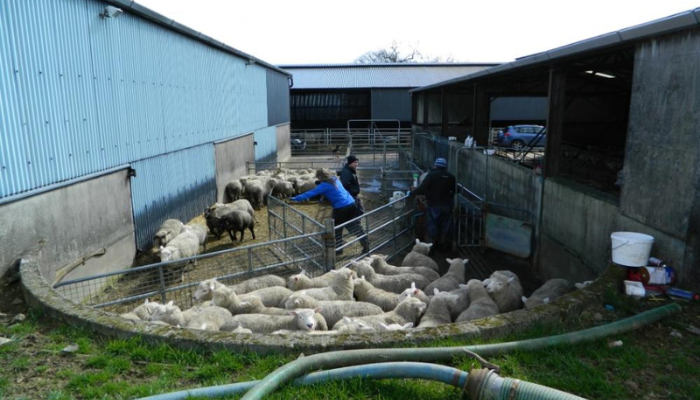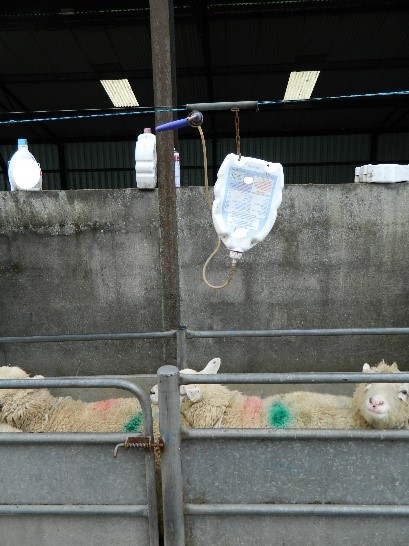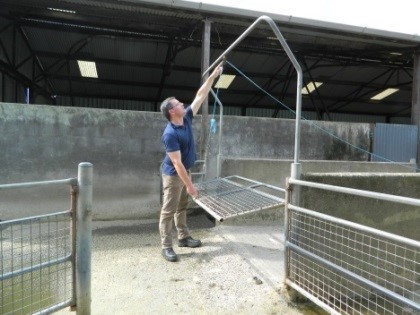23 June 2024
Investing in a sheep handling unit is an investment in yourself

Edward Egan, Drystock Advisor, Navan, Co. Meath, looks at the important factors to consider when designing a sheep handling unit.
If I was to give you one piece of advice it would be to always invest in yourself. Invest in the things that will improve your health & invest in the things that will save you time. If you’re a sheep farmer then investing in a well-designed sheep handling unit is the best investment that you can make in yourself.
A well-designed sheep handling unit is actually good for the handler’s health. A sheep farmer was telling me about an occasion when he was trying to catch one of his rams for his annual NCT in an oversized square pen. He did not have a forcing or rollover crate! Since he could not confine them properly he’d rush in behind the batch of rams & catch them one at a time. Catching the first few unsuspecting rams was easy enough but as the job went on the rams became wiser & wilder. With only a few rams to go the handler tried to catch a ram by putting his hand under the rams chin but the ram suddenly shot forward as his comrades cleared. The handler described the moment that he felt his arm stretching as his tendons tore. By the time he added in the pain, cost & the time of attending doctors, consultants & scans he reckoned he’d have a very good forcing pen paid for. I could tell you several other stories like this about trying to hold a sheep in one hand & needle in the other but I am sure you get the point!
A well designed sheep handling unit also saves you time. When sheep farmers talk about reducing the labour demands of their flocks or saving time they mention easier care sheep or outdoor lambing. However a guaranteed way of reducing the labour demands of your flock is by having a well-designed sheep handling unit. A survey by Liam Connolly of Teagasc showed that sheep farms with a good handling unit reduced the time worked per ewe by 18% or 1.28 hours per year. For every 100 ewe’s that 16 less working days per year. This saving in time is very important because in the modern world time is money. This saving in time also reduces the drudgery, improves the quality of the work the handler is doing & gives you more time with your family, friends or hobbies.
A well designed sheep handling unit will also encourage preventative practices. Having easy to use handling facilities encourages the timely completion of tasks that are critical to good flock performance & to minimising labour. Ease of use encourages use. Sheep need timely handling for jobs like foot-care, dosing, faecal egg counting, body condition scoring, dipping etc. For example, a farmer ask me to take a look at his lambs recently because they were not growing as well as he expected. The first thing that struck me when I saw the lambs was how many of them were lame. The farmer had a footbath, however it was not big enough to allow lambs an adequate stand-in time & the post-treatment standing area was not clean enough.
When designing your sheep handling unit it’s important to take into account that sheep farming is increasingly a one person operation. Teagasc have an 88 page booklet “A Guide to Designing a Sheep Handling Unit” which can be downloaded for free from www.teagasc.ie. This guide contains dozens of photos & diagrams of some of the best sheep handling units to be found on Irish sheep farms. You can also view the Teagasc YouTube video called “Designing a safe sheep handling unit” below:
60% TAMS 3 grant of sheep handling equipment
Under the TAMS 3 scheme called the Farm Safety Capital Investment Scheme (FCIS) there is a 60% grant rate, with a €90,000 investment ceiling on a wide range of both fixed & mobile sheep handling equipment. For the full list of eligible items & reference costs, click on the following link https://www.gov.ie/en/service/4255c-targeted-agricultural-modernisation-scheme-3-tams-3/
The following are the 12 key features to consider when to designing a sheep handling unit
1. Behaviour
To make handling sheep easier design a handling unit that will work with the sheep’s own behaviour. The aim is to incorporate features that encourage sheep into the unit & that draw them forward through it. The 5 key behaviours to consider include:
- Locate non-see through penning to block distractions from view. Locate see-through penning so sheep see escape routes or other sheep that draw them forward.
- Sheep want to be together.
- Sheep like to follow sheep.
- Using the flight behaviour. This requires a clear escape route e.g. a see-through gate at the race exit.
- Sheep are creatures of habitat so always use a similar route through the unit.
2. Location
The location of the handling unit must:
- Be convenient for the handler.
- Be easy to walk sheep to.
- Have safe vehicle access.
- Prevent pollution.
- Have water & electricity.
The 2 best locations for a handling unit are:
- In the farmyard & beside the sheep shed. This makes it easier to handle winter housed ewes for scanning, foot bathing, vaccination, condition scoring etc. This location also allows nearby sheds & yards to act as collecting pens.
- Central to the main grazing area. This minimises the walking distance for sheep & the handler.
3. Collecting Pen

3m wide collecting pen
The collecting pen must be big enough to hold regularly collected groups. 0.5m2/lowland ewe without lambs. 0.65m2/lowland ewe with lambs. Adjoining paddocks, sheds or roadways can be used as a holding pens for bigger groups.
Collecting Pen Shape & Width
Long narrow rectangular shaped pens make it easier for 1 person to push sheep forward. 3-4.6m is the ideal width because if it’s much wider sheep will retreat past the handler.
Collecting Pen Gates
Entrance & exit gates should be the same width as the collecting pen so there are no corners for sheep to run into. Pens should be interconnected with gates. This allows different batches of sheep to be recirculated within the unit.
4. Forcing Pen
The aim of the forcing pen is to give a steady flow of sheep into the race. Ideally the forcing pen will be in-line with the collecting pen. Avoid 90 degree turns from the collecting pens into the forcing pen. It should hold about 20% of the collected flock. 0.35m2/lowland ewe without lambs.
Forcing Pen Shape
The 3 options most popular options for forcing pen shape are:
- Funnelled shaped. Cheap & easy to build. Entry angle to the race should be 30
- Circular forcing pen. More expensive. 2 backing gates keep sheep pushed up. A 3.6m diameter pen should hold about 30 ewes.
- Semi-circular forcing pen. Cheaper to build & easier to drive sheep into. Use 3 backing gates.
5. Drafting Race
The drafting race is key to many jobs. It can be set-up to sort 2, 3 or 4 ways. Most 1 person units prefer a simple 2 way sorter. Sheep can be put through again for more sorting.
Drafting Race Location
Ideally locate the drafting race towards the centre of the unit or slight off centre. This allows drafting both left & right. You should never locate it against a wall because this limits handling to one side & it limits drafting to one side or to the end of the race.
Drafting Race Size
0.35m2/lowland ewe without lambs. A 6.1m x 0.5m race holds 8 unshorn ewes. If you’re going to handle sheep from outside the race then the race-sides should be 850mm high. Having it over 850mm makes it harder to reach sheep when their heads are down. The race should be at least 6.1m long. A longer race reduces the refilling time & gives more time to assess sheep coming towards you.
Race Floor
The race should have a concrete floor. The concrete should extend at least 600mm beyond the sides of the race. This gives the handler a firm & level walkway.
6. Sorting Gate
The sorting gates should at least 5m from the race entrance. Gates along the race side should be 1.2m long for easy exit & should be non-see through to reduce stalling. Sorting gates at the end of a race should be see-through to draw sheep forward.
Sorting Gate Handle
For a full hand grip handles should be at least 120mm long. Locate handles 150mm back from the front of the gate & at elbow height. Cover the handles with plastic piping to avoid handling metal during cold weather & to reduce vibrations.
7. Footbath
Lameness control requires a well designed footbath. It must be easy to use. A permanent footbath encourages regular use. Having a tap near the footbath makes it easier to fill & clean out. Allow tractor & tanker access for empting & filling.
Footbath Size
Bath size should be based on intervals of 250litres as most treatment products come in 25kgs bags. It should hold at least same number of sheep as the race/housing pens. Allow 0.4m2/lowland ewe.
Footbath Depth
The minimum solution starting depth is 5cm. Some start with a depth of 7.5cm. Many homemade baths are not deep enough.
Footbath Location
Most handlers prefer a standalone footbath. They can be made bigger allowing longer stand-in times. Footbaths located in the race become soiled & there size is limited.
Footbath Shape
The ideal footbath shape is a long rectangle. It should be 1.5-3m wide so that one stalling sheep cannot block it. Locate it to prevent pollution. It must never flood & it must never be in the way. The after treatment standing area should hold at least 4 times the number of sheep as the footbath. A concrete floor is ideal.
8. Dip Tub
Always locate & build it to prevent pollution. Dig a trial pit to check ground water levels. Tubs must not have a drain hole. Use manufactured one-piece units. 2 most common options to get sheep into the tub;
- Side entry from race with a slide. Popular with frequent dippers & larger flocks as less labour intensive.
- Lifting sheep into the tub. Popular with flocks of less than 100 ewes or if dipping is infrequent. It’s labour intensive.
Dip Tub Size
- 1,050-1,250 litres suits flocks of 100-250 ewes.
- 1,818-2,000 litres suits flocks of 250-500 ewes.
Dip Tub Cover
Galvanised steel covers are best. They are less slippy when wet compared to timber, they fit better & they last longer. Unsupervised dip tubs must be covered with a locked childproof cover.

Cover unsupervised dip tubs
9. Draining Pen & Filter
The job of the draining pens is to collect & send all dip back to the tub. Allow 0.5m2/lowland ewe in it. It must have a sloped leak-poof concrete floor. Having a pulley operated gate keeps handlers away from wet sheep. Draining pens should have a collection channel to divert dip back to the tub through a filter.
10. Handler Gates
Handler gates are important for handler safety. Locate them along the path the handler takes through the unit. They eliminate climbing & lifting over penning. Handler gates should be 500-550mm wide.
11. Dosing Line
Install a dosing line 1.85m above floor level. Along the length of the race. Dosing packs can be hung from this line. The handler is freed from carrying the pack & gun making the job of dosing quicker & easier.

Dosing line over the race
12. Pulleys & Weights
Reduce the amount of walking & lifting the handler has to do when opening gates by using pulleys & counterweights. Enclose counterweights so they do not come into contact with the handler or sheep.

Pulley operated swing gate
This article first appeared on Teagasc Daily in July 2023.
